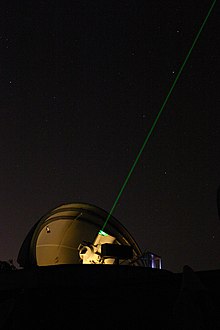Satellite laser ranging
This article includes a list of general references, but it lacks sufficient corresponding inline citations. (November 2020) |

In satellite laser ranging (SLR) a global network of observation stations measures the round trip time of flight of ultrashort pulses of light to satellites equipped with retroreflectors. This provides instantaneous range measurements of millimeter level precision which can be accumulated to provide accurate measurement of orbits and a host of important scientific data. The laser pulse can also be reflected by the surface of a satellite without a retroreflector, which is used for tracking space debris.[1]
Satellite laser ranging is a proven geodetic technique with significant potential for important contributions to scientific studies of the earth/atmosphere/ocean system. It is the most accurate technique currently available to determine the geocentric position of an Earth satellite, allowing for the precise calibration of radar altimeters and separation of long-term instrumentation drift from secular changes in ocean topography.
Its ability to measure the variations over time in Earth's gravity field and to monitor motion of the station network with respect to the geocenter, together with the capability to monitor vertical motion in an absolute system, makes it unique for modeling and evaluating long-term climate change by:[2]
- providing a reference system for post-glacial rebound, plate tectonics, sea level and ice volume change[3]
- determining the temporal mass redistribution of the solid earth, ocean, and atmosphere system[4]
- determining Earth orientation parameters, such as Earth pole coordinates and length-of-day variations[5]
- determining of precise satellite orbits for artificial satellites with and without active devices onboard[6][7]
- monitoring the response of the atmosphere to seasonal variations in solar heating.[8]
SLR provides a unique capability for verification of the predictions of the theory of general relativity, such as the frame-dragging effect.
SLR stations form an important part of the international network of
History

Laser ranging to a near-Earth satellite was first carried out by NASA in 1964 with the launch of the Beacon-B satellite. Since that time, ranging precision, spurred by scientific requirements, has improved by a factor of a thousand from a few metres to a few millimetres, and more satellites equipped with retroreflectors have been launched.
Several sets of retroreflectors were installed on Earth's
During the subsequent decades, the global satellite laser ranging network has evolved into a powerful source of data for studies of the solid Earth and its ocean and atmospheric systems. In addition, SLR provides
The International Laser Ranging Service was formed in 1998[9] by the global SLR community to enhance geophysical and geodetic research activities, replacing the previous CSTG Satellite and Laser Ranging Subcommission.
Applications
SLR data has provided the standard, highly accurate, long wavelength gravity field reference model which supports all precision orbit determination and provides the basis for studying temporal gravitational variations due to mass redistribution. The height of the geoid has been determined to less than ten centimeters at long wavelengths less than 1,500 km.
SLR provides mm/year accurate determinations of tectonic drift station motion on a global scale in a geocentric reference frame. Combined with gravity models and decadal changes in Earth rotation, these results contribute to modeling of convection in the Earth's mantle by providing constraints on related Earth interior processes. The velocity of the fiducial station in Hawaii is 70 mm/year and closely matches the rate of the background geophysical model.
List of satellites
List of passive satellites
Several dedicated laser ranging satellites were put in orbit:[10]
- Ajisai (Experimental Geodetic Payload)[11]
- BLITS[4]
- Calsphere satellites[12]
- Etalon[13]
- Kosmos 1989
- Kosmos 2024
- LAGEOS[14]
- LAGEOS 1
- LAGEOS 2, see STS-52
- LARES[15]
- LARES 1
- LARES 2
- Larets[16][17]
- STARSHINE
- Starlette and Stella[19]
Several satellites carried laser retroreflectors, sharing the bus with other instruments:
- Beacon Explorer-C)[20]
- Diadème (satellites)[20]
- PEOLE[20]
- CHAMP
- GRACE
- GOCE[21]
- Navigation satellites
- Altimeter satellites
See also
- Lidar
- Lunar laser ranging
- Retroreflector#In satellites
- Laser communication in space
References
- .
- S2CID 127408940.
- .
- ^ .
- .
- .
- S2CID 125791718.
- S2CID 127713034.
- S2CID 127335882.
- ^ "International Laser Ranging Service". Ilrs.gsfc.nasa.gov. Retrieved 2022-08-20.
- S2CID 191188229.
- ^ "Calsphere 1, 2, 3, 4". Space.skyrocket.de. Retrieved 2016-02-13.
- ^ Lindborg, Christina. "Etalon". Russia and Navigation Systems. Federation of American Scientists. Retrieved 10 November 2012.
- .
- .
- ^ "Larets".
- ^ "International Laser Ranging Service". Ilrs.gsfc.nasa.gov. Retrieved 2022-08-20.
- ^ "NASA - NSSDCA - Spacecraft - Details". Nssdc.gsfc.nasa.gov. 1999-06-05. Retrieved 2016-02-13.
- S2CID 121163799.
- ^ S2CID 127408940.
- S2CID 125791718.
- .
- .
- .
- .
- ^ "IRNSS: Reflector Information". ilrs.cddis.eosdis.nasa.gov. Archived from the original on 2019-03-25. Retrieved 2019-03-25.
- S2CID 134160047.
- .
- ISBN 9781510616196.
Further reading
- Pavlis, Erricos C.; Luceri, Vincenza; Otsubo, Toshimichi; Schreiber, Ulrich (eds) Satellite Laser Ranging Journal of Geodesy Volume 93, issue 11, November 2019
- "Satellite Laser Ranging and Earth Science" (PDF). NASA International Laser Ranging Service. Retrieved 2009-06-23. (public domain)
- Seeber, Günter (2003) Satellite Geodesy Walter de Gruyter ISBN 9783110175493pg 404
- Kramer, Herbert J. (2002) Observation of the Earth and Its Environment: Survey of Missions and Sensors Springer ISBN 9783540423881pg 131-132
- Turcotte, Donald L. (ed) (1993) Contributions of Space Geodesy to Geodynamics Washington, DC: American Geophysical Union Geodynamics Series, ISSN 0277-6669
- U.S. National Research Council (1985) Geodesy: a look to the future NAP pg 80-84
